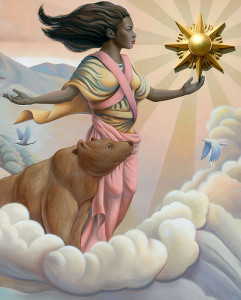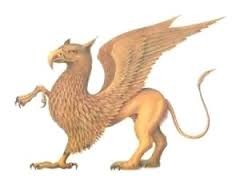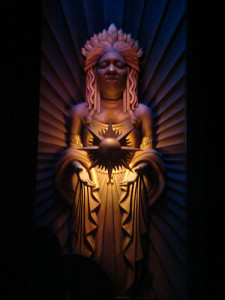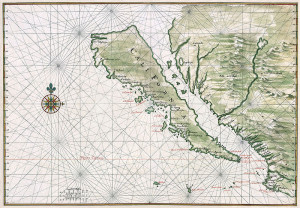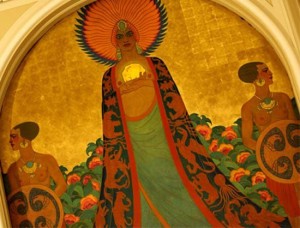Welcome to Amazon Month, Week 2!
Today we’re going to depart a little bit from the nature of this blog, and cover a woman whom we know absolutely did not exist at any point in time. Not even in the vague sense of Mulan probably existing in some real way but then evolving into a literary figure. Her story is 100% fiction, written by a Spanish novelist inspired by the classical Amazons.
But.
The story of Calafia (sometimes also spelled Califia or Khalifia), and what it inspired others to do, is so damn fascinating that it deserves to be told anyway! This entry will be half about Calafia, and half about the story of her story.
Around the year 1500 C.E., a Spanish author by the name of Garci Rodríguez de Montalvo wrote The Adventures of Esplandián, a chivalric, historical romance in which the character of Calafia appears.
Her name is probably a derivation of the Arabic word for ruler, ‘khalifa’. However, Calafia was not Muslim – she was pagan. And she ruled over an island nation, populated entirely by women. Montalvo describes her as a tall woman, ‘as black of the ace of clubs‘ and surpassingly beautiful. She is also described as being a very wise ruler, who wanted to do the best for her people and thereby leave her mark on history.
Montalvo does not hold back when he describes Calafia’s kingdom – far beyond the Indies (Montalvo does not specify East or West Indies), full of gold (but no other metals), and well-protected from invaders by tall cliffs and other geographic features.
Oh, and griffins. Lots and lots of griffins, ridden by Queen Calafia’s Amazon warriors and trained to tear apart any many they came across.
And the name of this wondrous place? The island of California.
The rough outline of Calafia as she appears in Montalvo’s work is thus:
Radiaro, a Muslim man, somehow makes it past the man-eating griffins and is granted an audience with Queen Calafia. He requests aid from the pagan queen; his home city of Constantinople is overtaken by Christian invaders and he needs help to fend them off. Queen Calafia, thinking now is as good a time as any for a fight, agrees to help him. She marshals her army of griffin-riding warrior women and they sail from California to Constantinople.
At first, Calafia’s forces are successful, as the griffins gleefully snatch Christian men from the ramparts surrounding the city and destroy them. However, as the Muslim forces move in to take the city, the griffins don’t stop. They can only distinguish between male and female; they can’t tell Christian from Muslim, and keep up the snatch-and-eat until the Muslims are forced to retreat and Calafia calls her griffins back.
Calafia’s new strategy is to challenge the Christian king in Constantinople to a duel – single combat, winner-take-all. The King accepts, and brings his entourage out to meet Calafia and her entourage. There’s a bit of love at first sight between Calafia and one of the king’s sons, Esplandián himself. Calafia tries to show off and attract his attention, but Esplandián isn’t interested in a pagan woman who doesn’t know her place.
The next day, Calafia and her buddy Radiaro fight the king and Esplandián. Predictably for a book written by a 16th century Spaniard, the forces of Christianity prevail. Not only is Calafia defeated, but she converts to Christianity, marries a knight named Talanque and returns back to California with the intent of opening up the island to men. The story continues without her, but Calafia had captured the Spanish imagination, as The Adventures of Esplandián became wildly popular in Spain. Most readers sort of ignored Calafia’s end, and kept alive the idea of the pagan Amazon queen.
Among the readers was explorer and conquistador, Hernando Cortez (most famous for hastening the fall of the Aztec Empire and bringing Spanish influence to Mexico and the American West). He does not seem to have understood that The Adventures of Esplandián was fiction. Judging from his behavior, he seemed to think that Montalvo had written about a real place – and he was determined to find this fabled island of black Amazons decked out in gold and pearls.
After breaking apart the Aztecs and declaring himself Governor of Mexico, he funded several Spanish expeditions west, with the intention of finding California. When the leader of this expedition found Baja California, he at first believed he’d found an island. And more out of a sense of hope and optimism than anything else, he named the region ‘California’.
The name spread, with Spanish cartographers and explorers believing that the entire West Coast must be an island… because after all, that’s how Montalvo described it! As a result, many old maps often show Baja California and California as a large island. The captain of the expedition, Fortun Ximenez, was convinced he’d found the island of the Amazons, and really, really wanted to find the gold and griffins. He found neither – the griffins didn’t exist, and gold wouldn’t be discovered in California until 1848.
It does seem, however, that Ximenez kept wandering through California, asking the local tribes where all the women were, and was frequently told that a tribe comprised solely of women existed ‘somewhere over there.’ It’s possible the tribes were trying to get him to go away and leave them alone (or at least go mess with their enemies), and Ximenez kept up his ultimately fruitless search for quite awhile.
However, despite utterly failing to find the kingdom (queendom?) of Calafia, the name stuck – Spanish explorers kept labeling the area ‘California’ on their maps, even when cartographers finally realized the land was firmly attached to the rest of the North American continent and had nary a griffin in sight. Spanish settlers kept the name, referring to themselves as ‘Californios.’ And by the time the United States picked a fight with Mexico, the name had become permanently attached to the region, and California became the 31st state in 1850. Because of this, the American state of California, Baja California in Mexico and the surrounding regions have become linked to the mythical California – despite the fact that Montalvo never really described where Calafia’s island was, other than ‘really far away’ (using language meant to imply that you couldn’t get to California, it was a semi-mythical place).
Since then, Calafia has evolved into a symbol for women of color, especially Hispanic, Latina and black women, living in California and the Southwest. She’s become a favorite subject of folk art, often depicted as a black queen, sometimes surrounded by symbols of Californian identity.
Many Afro-centric historical revisionists wholeheartedly embrace the legend of Calafia, holding her up as a symbol of strong black womanhood and an indication that black people have lived in California for a very long itme. As her legend has evolved in this context, Calafia has been described as a Muurish woman, of direct African ancestry who ruled an empire stretching from Colorado to Mexico to Oregon. These stories usually leave out the griffins, instead focusing on a black African empire ruled by women which existed until the arrival of the Spanish. Again, there’s no archaeological evidence that this empire ever existed in the same land as Hollywood and Napa Valley; this is instead a legendary history.
Visitors to Disney’s California Adventure between 2001 and 2009 could watch Golden Dreams, a film about the history of California, narrated by Whoopi Goldberg as Calafia. In addition, a wide variety of places in California have been named after her. The collection of California university resources on Latin American history and culture is called the Calafia Collection; you can visit Calafia State Park in San Diego County or purchase wine from Calafia Cellars in Napa Valley; and even a Californian chapter of the Society for Creative Anachronism calls itself the Barony of Calafia (though why the barony’s heraldry includes a sea serpent and not a griffin, I couldn’t tell you!).
Resources
His Level Best: And Other Stories
